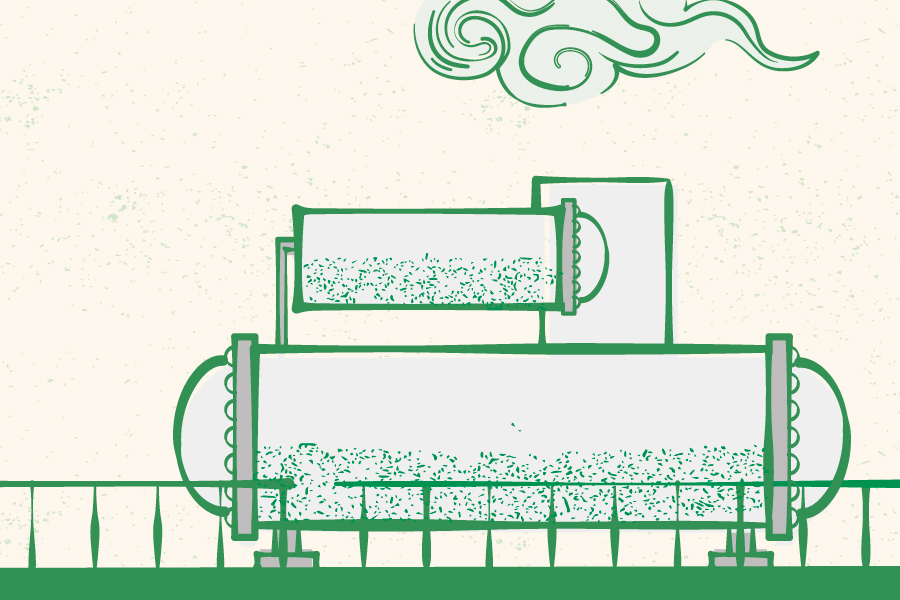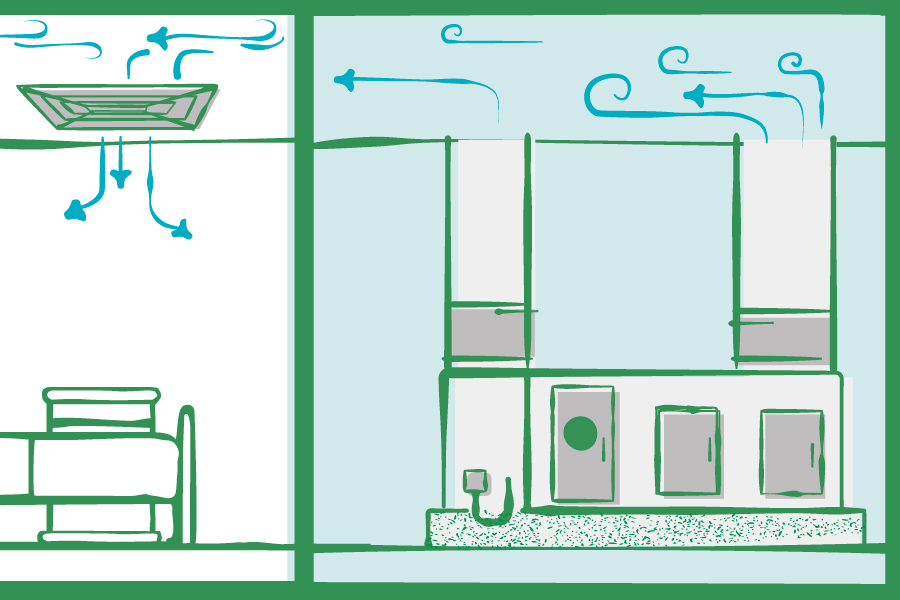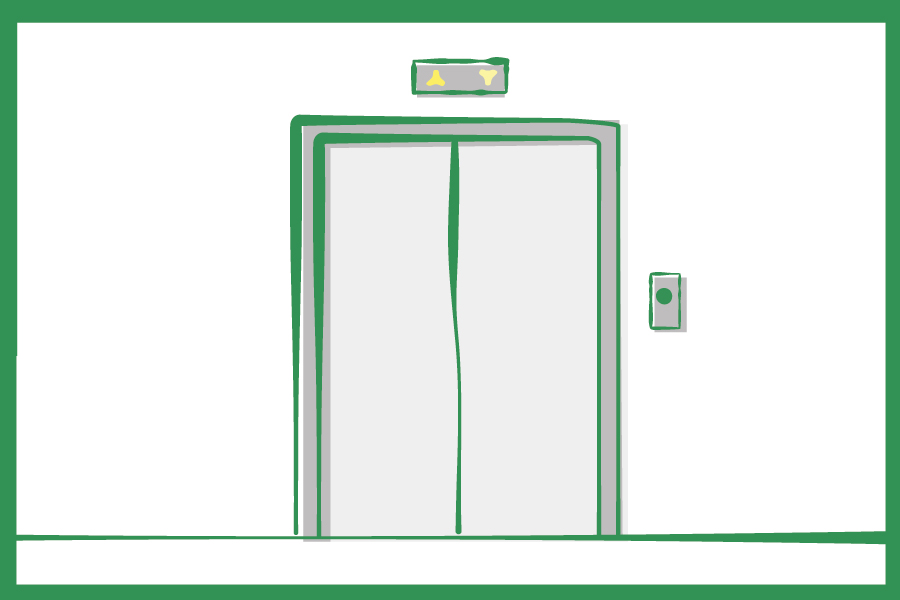Inside a green hospital
The Hospital Authority is committed to embracing environmental protection by integrating energy-saving and emission-reducing measures into the design and daily operations of hospitals. From solar panels on rooftops and outdoor automatic solar tracking lighting systems to energy-efficient air conditioning, LED lighting, and elevators, all are intelligently operated.
 Photovoltaic solar panels are connected to the grid and convert sunlight into renewable energy to help power the buildings. This process does not emit any greenhouse gases.
Photovoltaic solar panels are connected to the grid and convert sunlight into renewable energy to help power the buildings. This process does not emit any greenhouse gases.
 Chiller plants of central air conditioning system produce cold water for distribution to serve air conditioning systems inside buildings through a closed loop chilled water pipe network. Adopting water-cooled chillers allow the use of cooling towers with water as the cooling medium, which can provide better heat dissipation efficiency compared with air-cooled chillers and leads to significant energy savings.
Chiller plants of central air conditioning system produce cold water for distribution to serve air conditioning systems inside buildings through a closed loop chilled water pipe network. Adopting water-cooled chillers allow the use of cooling towers with water as the cooling medium, which can provide better heat dissipation efficiency compared with air-cooled chillers and leads to significant energy savings.
 An air handling unit (AHU) supplies the proper ventilation to the interior and with fresh air, the air is then circulated to reach each area through ducts. Using variable speed drive technology allows AHU to adjust its fan speed based on the required airflow. It can match the system’s load demands more precisely and reduce energy consumption when compared to a constant volume supply from fixed speed.
An air handling unit (AHU) supplies the proper ventilation to the interior and with fresh air, the air is then circulated to reach each area through ducts. Using variable speed drive technology allows AHU to adjust its fan speed based on the required airflow. It can match the system’s load demands more precisely and reduce energy consumption when compared to a constant volume supply from fixed speed.
 30 hospitals deliver more than seven tonnes of food waste a day to government food waste treatment facilities including O•PARK, the Food Waste/Sewage Sludge Anaerobic Co-digestion Trial Scheme at Sha Tin and Tai Po. The remaining hospitals use decomposers to convert food waste into liquid fertiliser.
30 hospitals deliver more than seven tonnes of food waste a day to government food waste treatment facilities including O•PARK, the Food Waste/Sewage Sludge Anaerobic Co-digestion Trial Scheme at Sha Tin and Tai Po. The remaining hospitals use decomposers to convert food waste into liquid fertiliser.
 A Variable Voltage Variable Frequency lift drive uses frequency inverter technology to precisely control the voltage and frequency of the motor, reducing power consumption by avoiding sudden acceleration and deceleration.
A Variable Voltage Variable Frequency lift drive uses frequency inverter technology to precisely control the voltage and frequency of the motor, reducing power consumption by avoiding sudden acceleration and deceleration.
 LED lighting consumes significantly less energy than incandescent or fluorescent bulbs. It converts a higher percentage of electrical energy into light, minimising energy consumption. They also have a longer lifespan, reducing the frequency of bulb replacements.
LED lighting consumes significantly less energy than incandescent or fluorescent bulbs. It converts a higher percentage of electrical energy into light, minimising energy consumption. They also have a longer lifespan, reducing the frequency of bulb replacements.
 Solar tracking lighting systems adjust the position of the lighting fixtures to ensure solar panels capture the maximum amount of sunlight for reflection and bring sunlight indoors for illumination.
Solar tracking lighting systems adjust the position of the lighting fixtures to ensure solar panels capture the maximum amount of sunlight for reflection and bring sunlight indoors for illumination.
Solar panels
 Photovoltaic solar panels are connected to the grid and convert sunlight into renewable energy to help power the buildings. This process does not emit any greenhouse gases.
Photovoltaic solar panels are connected to the grid and convert sunlight into renewable energy to help power the buildings. This process does not emit any greenhouse gases.
Water-cooled chiller
 Chiller plants of central air conditioning system produce cold water for distribution to serve air conditioning systems inside buildings through a closed loop chilled water pipe network. Adopting water-cooled chillers allow the use of cooling towers with water as the cooling medium, which can provide better heat dissipation efficiency compared with air-cooled chillers and leads to significant energy savings.
Chiller plants of central air conditioning system produce cold water for distribution to serve air conditioning systems inside buildings through a closed loop chilled water pipe network. Adopting water-cooled chillers allow the use of cooling towers with water as the cooling medium, which can provide better heat dissipation efficiency compared with air-cooled chillers and leads to significant energy savings.
Air handling unit with variable speed drive
 An air handling unit (AHU) supplies the proper ventilation to the interior and with fresh air, the air is then circulated to reach each area through ducts. Using variable speed drive technology allows AHU to adjust its fan speed based on the required airflow. It can match the system’s load demands more precisely and reduce energy consumption when compared to a constant volume supply from fixed speed.
An air handling unit (AHU) supplies the proper ventilation to the interior and with fresh air, the air is then circulated to reach each area through ducts. Using variable speed drive technology allows AHU to adjust its fan speed based on the required airflow. It can match the system’s load demands more precisely and reduce energy consumption when compared to a constant volume supply from fixed speed.
Food waste collection
 30 hospitals deliver more than seven tonnes of food waste a day to government food waste treatment facilities including O•PARK, the Food Waste/Sewage Sludge Anaerobic Co-digestion Trial Scheme at Sha Tin and Tai Po. The remaining hospitals use decomposers to convert food waste into liquid fertiliser.
30 hospitals deliver more than seven tonnes of food waste a day to government food waste treatment facilities including O•PARK, the Food Waste/Sewage Sludge Anaerobic Co-digestion Trial Scheme at Sha Tin and Tai Po. The remaining hospitals use decomposers to convert food waste into liquid fertiliser.
Lifts
 A Variable Voltage Variable Frequency lift drive uses frequency inverter technology to precisely control the voltage and frequency of the motor, reducing power consumption by avoiding sudden acceleration and deceleration.
A Variable Voltage Variable Frequency lift drive uses frequency inverter technology to precisely control the voltage and frequency of the motor, reducing power consumption by avoiding sudden acceleration and deceleration.
LED lighting
 LED lighting consumes significantly less energy than incandescent or fluorescent bulbs. It converts a higher percentage of electrical energy into light, minimising energy consumption. They also have a longer lifespan, reducing the frequency of bulb replacements.
LED lighting consumes significantly less energy than incandescent or fluorescent bulbs. It converts a higher percentage of electrical energy into light, minimising energy consumption. They also have a longer lifespan, reducing the frequency of bulb replacements.
Automatic solar tracking lighting system
 Solar tracking lighting systems adjust the position of the lighting fixtures to ensure solar panels capture the maximum amount of sunlight for reflection and bring sunlight indoors for illumination.
Solar tracking lighting systems adjust the position of the lighting fixtures to ensure solar panels capture the maximum amount of sunlight for reflection and bring sunlight indoors for illumination.